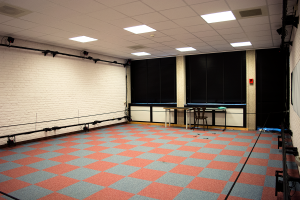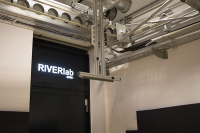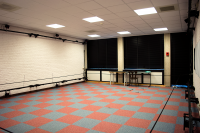Difference between revisions of "RIVER Lab/Legacy"
m |
|||
| (20 intermediate revisions by the same user not shown) | |||
| Line 5: | Line 5: | ||
| label1 = Location | | label1 = Location | ||
| data1 = B.00.12a (RIVER Lab 1),<br/>B.00.10 (RIVER Lab 2) | | data1 = B.00.12a (RIVER Lab 1),<br/>B.00.10 (RIVER Lab 2) | ||
| − | | manuals = | + | | manuals = {{bulleted list |
| + | | [[:File:riv2 quickstart.pdf|RIVER Lab 2 Oculus Quick Start Guide]] | ||
| + | | [[:File:Vive_riv2_quickstart.pdf|RIVER Lab 2 Vive Quick Start Guide]] | ||
| + | }} | ||
}} | }} | ||
| − | The Radboud Immersive Virtual Environment Research (RIVER) Labs | + | The Radboud Immersive Virtual Environment Research (RIVER) Labs 1 and 2 were two Behavioral Science Institute research labs dedicated to experiments in Virtual Reality (VR) in the Spinoza building. |
==Physical Properties== | ==Physical Properties== | ||
| Line 31: | Line 34: | ||
==Equipment== | ==Equipment== | ||
| − | Both RIVER labs come with special equipment for creating a digital immersive virtual environment. The following specifications apply to the current lab setup, operational since January 2014. For older specifications, please contact the [ | + | Both RIVER labs come with special equipment for creating a digital immersive virtual environment. The following specifications apply to the current lab setup, operational since January 2014. For older specifications, please contact the [[RIVER_Lab/manager|lab manager]]. |
{| class="wikitable" | {| class="wikitable" | ||
| Line 57: | Line 60: | ||
! scope="row" colspan="2" | | ! scope="row" colspan="2" | | ||
|- | |- | ||
| − | | Wireless VR || style="background-color:#F99;" | No || style="background-color:# | + | | Wireless VR || style="background-color:#F99;" | No || style="background-color:#FFB;" | No<ref>Possible with Oculus Rift DK1 only.</ref> |
|- | |- | ||
| − | | Stimulus PC || [[Dell_Precision_T-series#T3610|Dell Precision T3610]] || [[ | + | | Stimulus PC || [[Dell_Precision_T-series#T3610|Dell Precision T3610]]<ref name="stimpc">Different graphics card installed (GTX1060 or GTX1080). For exact up-to-date specifications, please contact the [[RIVER_Labs/manager|lab manager]] </ref> || [[Dell_Precision_T-series#T3610|Dell Precision T3610]]<ref name="stimpc"/> |
|- | |- | ||
| − | | Stimulus Software || colspan="2" style="text-align:center"| [http://www.worldviz.com/products/vizard Worldviz Vizard 4.0] | + | | Stimulus Software || colspan="2" style="text-align:center"| [http://www.worldviz.com/products/vizard Worldviz Vizard 4.0], [https://unity3d.com/ Unity] |
|} | |} | ||
| Line 70: | Line 73: | ||
! scope="col"| Nvis Nvisor SX60 | ! scope="col"| Nvis Nvisor SX60 | ||
! scope="col"| Oculus Rift Dev. Kit 1 | ! scope="col"| Oculus Rift Dev. Kit 1 | ||
| − | ! scope="col"| | + | ! scope="col"| HTC Vive |
|- | |- | ||
| − | | In service || style="text-align:center;" | 2006 - October 2013 || style="text-align:center;" | November 2013 - || style="text-align:center;" | | + | | In service || style="text-align:center;" | 2006 - October 2013 || style="text-align:center;" | November 2013 - 2017 || style="text-align:center;" | November 2016 - |
|} | |} | ||
| − | In RIVER Lab 2, five retro-reflective markers are attached to the [[Head Mounted Displays | Head Mounted Display]] via a custom 3D-printed frame for tracking the participant's position and orientation; any internal tracking in the HMD is disabled. | + | In RIVER Lab 2, five retro-reflective markers are attached to the [[Head Mounted Displays | Head Mounted Display]] (except HTC Vive) via a custom 3D-printed frame for tracking the participant's position and orientation; any internal tracking in the HMD is disabled. |
| + | ==== Vive ==== | ||
| + | As of November 2016, standard HTC Vive setups are available in both RIVER Labs. These setups use the Vive's own "Lighthouse" tracking system instead of the lab's, and a standard [[Computers#Lab_Computer | Lab Computer]] (with upgraded graphics card). No wireless solution is available for the Vive (yet), so the tracking area is limited by the length of the cable and the range of the Lighthouse tracking system. | ||
| + | As of September 2017, the Vive in RIVER Lab 2 has been equipped with the Deluxe Audio Strap, which has built-in headphones. | ||
| + | |||
| + | <!-- // MARKED FOR OBSOLESENCE | ||
=== Stimulus PC (RIVER Lab 2) === | === Stimulus PC (RIVER Lab 2) === | ||
{| class="wikitable" | {| class="wikitable" | ||
| Line 97: | Line 105: | ||
| Storage || Samsung SSD 840 EVO, 128GB | | Storage || Samsung SSD 840 EVO, 128GB | ||
|} | |} | ||
| − | |||
=== Other Equipment === | === Other Equipment === | ||
| − | In RIVER Lab 2, the following equipment is used to help create a fully wireless, low latency virtual reality experience: | + | In RIVER Lab 2, the following equipment is used to help create a fully wireless, low latency virtual reality experience (applies to Oculus DK1 only!): |
*IOGear GW3DHDKIT wireless HDMI transmitter.<ref>http://www.iogear.com/product/GW3DHDKIT/</ref> | *IOGear GW3DHDKIT wireless HDMI transmitter.<ref>http://www.iogear.com/product/GW3DHDKIT/</ref> | ||
*Anker Astro Pro 14400mAh external battery.<ref>http://www.ianker.com/support-c1-g212.html</ref> | *Anker Astro Pro 14400mAh external battery.<ref>http://www.ianker.com/support-c1-g212.html</ref> | ||
*Sennheiser RS160 wireless headphones.<ref>http://en-us.sennheiser.com/wireless-audio-headphones-digital-rs-160</ref> | *Sennheiser RS160 wireless headphones.<ref>http://en-us.sennheiser.com/wireless-audio-headphones-digital-rs-160</ref> | ||
| − | | + | |
| − | + | --> | |
==See Also== | ==See Also== | ||
*[[Head Mounted Displays]] | *[[Head Mounted Displays]] | ||
Latest revision as of 17:16, 15 March 2023
 RIVER Lab 2 in 2015 | |
| Location | B.00.12a (RIVER Lab 1), B.00.10 (RIVER Lab 2) |
|---|---|
| Manuals | |
The Radboud Immersive Virtual Environment Research (RIVER) Labs 1 and 2 were two Behavioral Science Institute research labs dedicated to experiments in Virtual Reality (VR) in the Spinoza building.
Physical Properties

|

| |
|---|---|---|
| RIVER Lab 1 | RIVER Lab 2 | |
| Room Properties | ||
| Room Number | B.00.12a | B.00.10 |
| Room Size[1] (m) | 4.0 * 8.0 | 5.0 * 7.2 |
Equipment
Both RIVER labs come with special equipment for creating a digital immersive virtual environment. The following specifications apply to the current lab setup, operational since January 2014. For older specifications, please contact the lab manager.
| RIVER Lab 1 | RIVER Lab 2 | |
|---|---|---|
| Tracking | ||
| Tracking System | Intersense IS-900 | AR-Tracking ARTTRACK3 |
| Type | Inertial-Ultrasound Hybrid | Optical, 16 Cameras |
| Accuracy (mm) | 0.75 - 3.0 | <1.0 |
| Update Rate (Hz) | 180 | 60 |
| Tracking Software | Intersense Server | AR-Tracking DTrack 2.0 |
| Tracker Type | Inertial-Ultrasound Hybrid Sensor | Passive retro-reflective markers |
| Virtual Reality | ||
| Wireless VR | No | No[2] |
| Stimulus PC | Dell Precision T3610[3] | Dell Precision T3610[3] |
| Stimulus Software | Worldviz Vizard 4.0, Unity | |
Head Mounted Displays
| Nvis Nvisor SX60 | Oculus Rift Dev. Kit 1 | HTC Vive | |
|---|---|---|---|
| In service | 2006 - October 2013 | November 2013 - 2017 | November 2016 - |
In RIVER Lab 2, five retro-reflective markers are attached to the Head Mounted Display (except HTC Vive) via a custom 3D-printed frame for tracking the participant's position and orientation; any internal tracking in the HMD is disabled.
Vive
As of November 2016, standard HTC Vive setups are available in both RIVER Labs. These setups use the Vive's own "Lighthouse" tracking system instead of the lab's, and a standard Lab Computer (with upgraded graphics card). No wireless solution is available for the Vive (yet), so the tracking area is limited by the length of the cable and the range of the Lighthouse tracking system. As of September 2017, the Vive in RIVER Lab 2 has been equipped with the Deluxe Audio Strap, which has built-in headphones.
See Also
References
- ↑ Effective tracking area
- ↑ Possible with Oculus Rift DK1 only.
- ↑ 3.0 3.1 Different graphics card installed (GTX1060 or GTX1080). For exact up-to-date specifications, please contact the lab manager